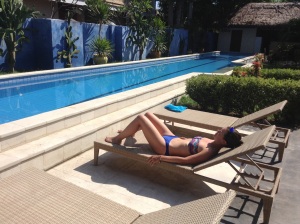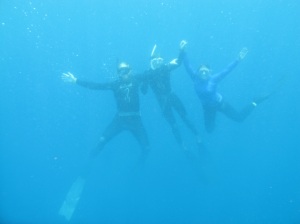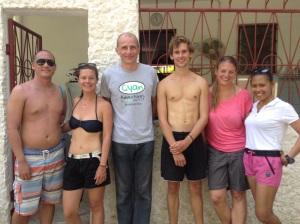I felt a gentle squeeze on my arm and flicked my finger in reply to signal that I was ok. ‘That’s 2:40.’ It was Helena’s voice – distant but near, muffled but clear, muted somewhat by my being face down in the water. Two minutes forty… taking a glance at the bottom of the pool, I took a check of how I was doing. Calm, focused, in control, not struggling, not yet. ‘Make it to three minutes.’ This was a voice in my head urging me on, gently but with determination. So I stayed put, face down, floating, holding my breath, knowing I’d already passed the two minute requirement for this course, realising that I’d far surpassed what I thought possible a few hours earlier, and keen to find out where the limit actually lay.
‘Three minutes.’ Another squeeze of the arm, another signal in reply – but by now, my diaphragm was twitching, sending the signals to my brain that I needed to breath. Wolfgang had explained these ‘contractions’ to us, taught us that it is increased carbon dioxide levels that trigger them, not a lack of oxygen – well, not yet. So I tried to ignore them – clear mind, calm, still, quiet, letting the seconds tick on.
‘Three fifteen,’ and I was having to work hard now, my stomach crunching in its desire to make me want to breathe. Can I make it to 3:30, I wondered, and held on. Another squeeze, ‘3:30’, and I came up. Looking around I saw Helena, stopwatch in hand, looking excited and Wolfgang, who had been observing, looking calm but pleased. ‘How was it?’ he asked, softly. ‘It was, it was … good,’ I replied, trying to grasp the moment and hold on to whatever feeling it was that was flooding my senses. He simply smiled.

Freediving – the sport (or art?) of diving underwater while holding your breath. Unlike scuba diving, there is no heavy breathing apparatus involved, so the free diver relies solely on their ability to move under the surface as efficiently as possible to conserve oxygen while staving off the urge to breath through a combination of training and mental preparation. After being told I couldn’t scuba due to my asthma, Freediving seemed like not only the best way to be able to enjoy the ocean, but also a good chance to get back to thinking ‘I can’ after being told so categorically, ‘You can’t’.
This blog then, is the bit that was missing from the last Philippines blog – the bit from Cebu, or Moalboal to be more precise. Having decided on Freediving as an option, Helena was looking through the Philippines guide book and came across a section about Wolfgang Dafert, free diver extraordinaire who runs courses from his Moalboal base. We got in touch, and booked two slots.
On day one, we got a trike to the beautiful Serena Bay Resort where we were to begin our training. We met Wolfgang and were immediately struck by his calm demeanour and his down to earth, absorbingly welcoming manner. As we were a course of seven people, we were also introduced to two more instructors, Gadie and Rinate. In addition to myself and Helena there was: Matias, a Norwegian, Sarah from Switzerland, the American Peter and two Aussies, Brendan and Robert. Wolfgang asked why each of us had come to the course, and we all had our various reasons, (mine to prove something to myself and the scuba instructors on Ko Tao I guess) but I remember Brendan and Robert’s replies most clearly. Brendan was into spear fishing in Australia, and so was keen to learn a bit of technique to allow him to stay down longer (and spear larger fish perhaps). ‘And you?’ asked Wolfgang of Robert, ‘I’m just here with him,’ he replied casually, indicating Brendan. This response became more significant as the days went on as Robert proved to be a particularly capable free diver, having no issues swimming at depth and performing a static breath hold of four and a half minutes on the first morning.
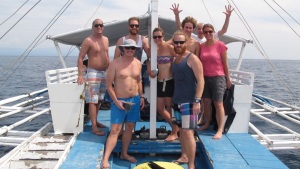
You know, if you’re reading this, just have a little go now. Take a couple of deep breaths, relax, and then hold your breath. Look at the clock, see how far you get. Then, when you feel the need to breath, do two things: 1 – breath!! But 2 – see how much longer away four and a half minutes is. Staggering, isn’t it!
Wolfgang began by explaining a lot of the theory and safety to do with Freediving, particularly focusing on the physiological effects of the activity on the body. I won’t go into detail here but safe to say the body is incredible in its ability to adapt under pressure – literally. We learned about oxygen consumption, Boyle’s law of pressure and the consequent need to ‘equalise’ – I’ll explain a little more of this later. He also told us about the requirements to pass the course: we had to do a two minute static breath hold in the pool, swim 40m horizontally under the surface of the pool with fins, and complete a dive to 16m depth.
The two minute breath hold seemed crazy at first. It’s safe to say that we were all more than a little nervous (and pretty doubtful) that we could manage it – perhaps with the exception of Robert who happened to mention he had done three and a half minutes before ‘just for fun’ as part of his competitive swim training.
Soon, we were in the pool – a beautiful, warm little outdoor pool, just up from the beach and the clear waters beyond. Wolfgang uses Serena Bay for its quiet location, absolutely key to getting a good start, making it easier to relax and focus. Kitted out with wetsuits, masks and snorkels, he talked us through some breathing and relaxation techniques. With our heads rested on the side of the pool, he explained ‘belly breathing’ to us – utilising the diaphragm rather than the intercostals to fill the lungs from the bottom which also has the effect of slowing the heart rate. We closed our eyes, closed our minds, and focused.
Before long, after a demonstration from Gadie, it was time to have a go. ‘Are we going to have to do the two minutes today do you think?’ I asked Hels quietly. ‘Looks that way,’ she replied. I had thought all of the testing/assessing would be done on the final day – seems not! ‘Do you want to go first?’ she asked. So after preparing, I took a deep breath, here goes…
And there I was, face down in the pool, holding my breath. Not really knowing what to expect, all sorts of things happened. Firstly, I started drifting around in the water. What if I bump into someone else? Then I felt like I was spinning, but a look at the bottom of the pool confirmed I definitely wasn’t. That’s weird, I thought. Then Hels squeezed my arm to signal a minute had passed. Wow, a minute! Damn, I need to breath… No you don’t, relax. For a few seconds then, I began to feel the incomparable peace and stillness of breath holding – when there isn’t even the the sound of air passing in and out of your lungs to disturb the tranquility. It was only momentary that first time though as I could sense that the others were still under the water too so then a bit of (utterly pointless) competitiveness crept in – just stay down until you notice someone else come up, don’t be the first, just … hold … on … a … little … longer… And then the urge to breath was too much, so I came up. As the air flooded back into my lungs, Helena said, ‘1:53’. ‘Wow, really?’ was my initial reply, and then immediately – ‘Seven more seconds, damn!’ Looking over, I saw that Sarah had come up but Matias was still face down, being watched over by Peter. (He stayed down for over three minutes on his first attempt!).
This session went on to last about 90 minutes, and by the end of it, not only had every single one of us held out breath for over two minutes, we were all also stunned by the intoxication of the experience. ‘It’s so…. I don’t know!’ was about the best I could come up with at the time to describe it – and I’m clearly doing no better now! All we did know, however, was that we all wanted more.
The afternoon session was more theory, ‘How to avoid a blackout while free diving’ – pretty critical stuff really, before going back to the pool for dynamic training. This time, we had to swim 40m underwater with fins. Having done the static in the morning, I was super confident, thinking ’40m really isn’t that far now I know I can hold my breath for over three minutes.’ Unfortunately, there is a vast difference between holding your breath while staying still, and holding your breath while swimming – the latter being vastly more demanding on the body’s oxygen supply. So although we all passed, each one of us getting to 48m (three lengths of the 16m pool) it was nowhere near as simple as I had momentarily thought.
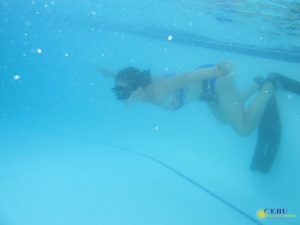
At the end of day one, we all had two out of three requirements passed, with only one to go – the deep dive. The next morning – after having met up for a meal and drinks with a few of the guys the night before – we all regrouped and climbed aboard the St. Vincent – I had to take a picture for my Dad! It was only a short boat ride out to the dive site which Wolfgang explained was to be a dive into ‘the blue’, meaning simply that the water would be deep. Very deep.
We checked our equipment: wetsuit, mask, snorkel, long fins, weight belt. The last piece of kit (the weight belt) is the thing that can be a little unnerving – diving down into the ocean with two kilos strapped around your waist could be perceived as foolhardy, I suppose. It is very necessary however as, with lungs full of air, the body is a very buoyant object. It’s just best to make sure the lungs stay full and you don’t inadvertently breath out 20m below the surface!
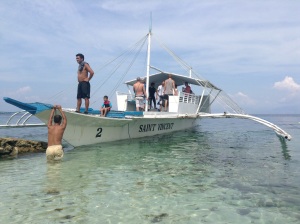
So, a little bit about ‘equalising’ – the head has air spaces inside of it, namely the inner ear and the sinuses. As the pressure of the water increased with depth (Boyle’s Law), it pushes your ear drums in so that they look like these parentheses: ) ( Without equalising, the eardrums would eventually burst – not nice! Also, as the air squeezes in the sinuses, it can cause pain across the front of your face – very unpleasant. To counteract this then, divers learn to ‘equalise’ by closing their mouth, holding their nose and ‘blowing’ air into the inner ear and sinuses – it’s the same as what you have to do on an aeroplane sometimes.
Equalising causes the most problems to divers, especially when trying to descend head first. At the beginning of our deep dive day then, Wolfgang started us off by descending feet first to get used to equalising under the surface. He and Rinate set up three training lines for us – ropes with weights at the bottom, lowered into the water off the outriggers of the St Vincent. We each took it in turns to descend the ropes, equalising as we go.
‘The lines are set to ten metres,’ he said, and looking down into the blue below me, I could see the concrete weight dangling in the distance. ‘There is a black tape every five metres,’ he continued, ‘so take it easy, don’t push it, just go a little bit and come back up.’ After another demonstration from Gadie, I wrapped my feet around the rope, took my last preparatory breath, and started to descend. Immediately, I could feel the pressure on my ears, but equalising regularly, I descended pretty comfortably down to the five metre mark and stopped.
I stayed for a few seconds holding the rope and pretty much fell in love with Freediving right there, under the water. A huge sense of calm rushed over me, as I slowly took in the scene, the big blue, the stillness, the quiet, the strange security of the sea, the permanence and power of it, the vastness of it, the subtle simplicity of not breathing.
Helena was the same although she remembers looking around and noticing the sunlight, streaking into the water around her. There is a point down below you at which all of the light converges, and it was – and continues to be – this that intoxicated her the most. She describes it as the epicentre of calm, the representation of all of the euphoric feelings you get under the water.
After reaching ten metres feet-down, we then tried to go head first instead – this was an entirely different ball game. The equalising becomes much more difficult as the air is now trying to stay in your lungs rather than being forced into your head (as you are now upside down, the air is ‘floating’ towards your diaphragm. The first time I tried, I got sudden, sharp pains right across my forehead, like someone was hammering nails into the bridge of my nose. Even at five metres, it was too much, I had to come up.

So, these were my sinuses, giving me grief. I was worried that I may not be able to dive after all. I mentioned it to Wolfgang and he told me to, ‘Stay on top of the equalising,’ basically, to stay in front of the pain. Luckily, after a few more attempts taking it slowly, I learned how to keep putting pressure into my ears and sinuses which allowed me to dive to ten metres without a problem. But that was ten metres, only ten metres, nowhere near sixteen!
We had a lunch break, and a chance to practise our skills snorkelling and diving over the coral near the shore and amongst the huge shoals of sardines for which Moalboal is famous. We also said farewell to Brendan and Robert who were doing a shorter introductory course.
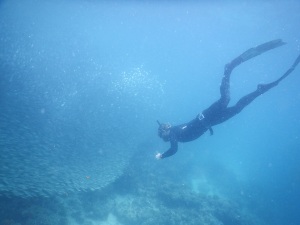
In the afternoon, we went back into open water, but this time the lines went deeper…
One of the lines went to 18 metres, to give us the opportunity to make the required depth for the course. Matias was doing well, swimming seemingly comfortably off into the deep and coming back safely. I began to push the depth a bit, 12 metres, 13, gradually feeling more confident but I’d be lying if I said the nerves weren’t creeping in steadily too. Wolfgang was encouraging me to dive deeper so I resolved to give it my best shot to make the 16 metres. On my first concerted attempt, I forgot to equalise properly and my sinuses were giving off the drilling pain by about 8 metres, so I turned and came back.
On my second attempt, I was about 12 metres down and then I spotted a turtle swimming in the distance. I was so excited that I grabbed the line and stopped to watch it. I didn’t feel so bad about aborting the dive, but I knew I’d have to go again.
The final attempt. I prepared on the surface, cool, calm belly breathing, staying relaxed. Then I came to the line and looked down, breathing through the snorkel with my face in the water. The weight was at 18 metres, and just beginning to dissolve into the blue. I took my final breath, and dived down.
I swam in front of the rope, using it to guide me straight down. The five metre mark went past my eyes – keep kicking. Equalising constantly, my ears and sinuses were keeping up, and I was going deeper still. Ten metres – keep going. Fifteen metres – just a little more… I looked up and could see the weight a little way in front of me. I was feeling a mix of excitement, panic and fear – what am I doing? I’m almost 18 metres under the surface and I already feel like I need to breath. Just a little more…
And then the urge to breath overcame me, I turned on the rope just short of the weight and started to ascend. The markers came back past – 15 metres, 10 metres. Wolfgang had come down to meet me as a safety diver and was ascending with me, making eye contact to check I was ok. 5 metres … You’re going to make it. And then my head broke the surface. Taking in big gulps of air, I looked at Wolfgang, ‘Did I make it?’ ‘Yep,’ he replied, ‘17.5’.
I was over the moon.
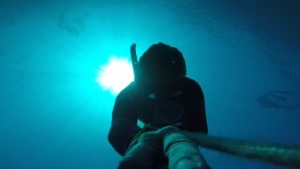
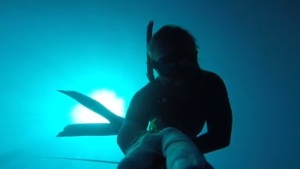

On the final day, we went to Wolfgang’s apartment on the coast – there was the small matter of the final exam to take. We worked our way through it. It was a bit odd actually. Although I’ve prepared students for all sorts of exams for the last 8 years, I haven’t sat one myself for ages! Matias and myself were bottom of the class on the exam front, while Helena aced it! And then we walked into the sea off the beach, gazing at the coral and sea life before the sea bed dropped off sharply allowing a good depth for diving.
This was the final day – Matias and I had made the 16 metres the day before, so spent our time practising and developing our skills. Peter and Helena were struggling to equalise head down so worked on getting more comfortable with that, and Sarah made her deep dive to pass the course.

So it was an incredible few days. The static breath hold and the deep dives in particular were fantastic experiences. Having been doing sports for the last fifteen years where you basically have to push harder, go faster and further than you thought possible, the mindful, calm, focused approach that Freediving requires was a refreshing change.
So what next?
Well, we went to Boracay and immediately found Freedive Boracay – a great group of divers coached by Cat. We went out with them for a fun diving session where I worked on getting more comfortable at depth, and Cat gave Helena some more tips for equalising to work on. He also introduced me to the concept of ‘bottom time’. We were diving on a line that was 18 metres deep, and rather than it be a struggle, the aim now was to dive calmly down, hang there on the bottom for a short while, before coming back up. Which I did!
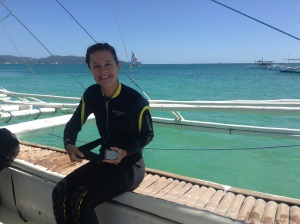
Following on, keen to keep practising, we found another school on Gili Trawangan where we could ‘fun dive’ for a whole week. ‘Have we got enough time to stay a week, do you think?’ I asked Helena. ‘I don’t see why not…’ And so, for a week on Gili T, we went out diving each day in the morning with a large group of divers: students, fun divers and instructors. It was so good to be able to chat to all the guys and girls there and glean tips and advice as we went along.
The other thing to mention about Freedive Gili is that a lot of these guys are currently competing. Outside the shop, they have a ‘Hall of Fame’ board where some of the numbers are truly staggering. Some of these guys are diving well in excess of 70, 80, 90 metres. An incredible set of athletes.
During this week, Hels and I both made great progress. Helena’s equalising is getting much better, and she made a dive to ten metres head down on the final day. Still a little way to get the 16m for the certificate but it’s within reach. She also improved her static time to 3:15. As for me, I dived to 24 metres on the first day (wow!) and then gradually added depth each day until the final day where, with good conditions, I reached 30 metres.

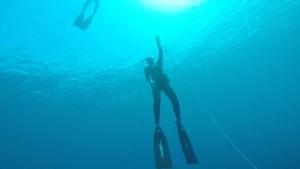
So to end, we just want to say a little thank you to everyone who has helped us on our journey into Freediving so far: at Freedive Gili, Gary, Irene, Per, Viktor, Akim and Denis; Cat and all the guys at Freedive Boracay; and of course, the exceptional Wolfgang Dafert, Gadie and Rinate from Freediving Philippines. Thanks guys 🙂
